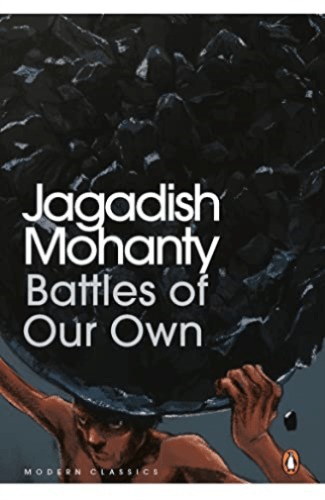
Battles of Our Own by Jagadish Mohanty, translated by Himansu Mohapatra and Paul St. Pierre, describes a series of battles against the background of a colliery in western Odisha. The modern era has no place for epic heroes grappling with Dharma and Adharma on the vast fields of Kurukshetra. These are rather petty battles in the lives of small and corrupt men struggling to keep their dignity intact in a modern world. There is a no single hero or protagonist in the novel but many people who confront each other, trying to further their own personal gains. There is Pradyumna Mishra, a Brahmin boy who procures employment as a wage labourer under the false name of a tribal. He is thus condemned to suffer a double life – an educated youth when outside the colliery and an uneducated tribal labourer when he descends into the bowels of the earth. Pradyumna lives with his uncle Agani Hota a wily supervisor and small time union leader. The management is represented by the high-handed general manager Mr. Mirchandani and the forever nervous project manager Mr. Deshmukh – each one insecure in his position and each one looking out for opportunities to put others in their place.
Set in the period of 1980s when the memories of pre-nationalisation coal companies is still alive, the novel takes us through several transitions in the ecological, political and psychological terrains. It describes how beautiful forests were cut down to extract coal and how after the extraction is completed the deserted mines bears an eerie cavernous look. The Tarbahar colliery is an underground mine and an apt metaphor for the modern human existence which is devoid of softer emotions, sensitivity and commitment to higher goals. The characters are involved in petty battles for survival and power, they are all inwardly disturbed and unable to deal with their inner turmoils. Men descend through the cave-like mouth into the dark, soot-laden bowels of the earth. The pitch blackness of the colliery is just like pitch blackness of the human soul where fear and violence lurks around the corner.
Jagadish Mohanty is a master novelist who touches almost every theme of modernising India – from unemployment, to women’s exploitation, to caste-based politics and violent and corrupt trade unionism. It rues the death of Gandhian commitment to truth and generosity in politics replaced by baser animal-like instincts. The novel is a classic industrial novel which describes the bleakness and blackness of industrial life in unrelenting language. The age of idealism in interpersonal relations as well as in trade unionism is replaced by the greed and cynicism of age of industry.
The plot of the book culminates in a violent confrontation of trade unions – one led by the vicious Dhruba Khatua backed by the Member of Parliament Hema Babu and other sought to be formed by Harishankar – an erstwhile protege of Heme Babu – and Agani Hota. Dhruba Khatua calls for a strike and Harishankar tries negotiate with the management for the recognition of his union. Things come to a head in which Pradyumna is severly beaten up and Harishankar Babu is convinced by his lieutenant Agani Hota to sit for a hunger strike. The management by-passes Harishankar in order to strike a deal with Agani Hota to ensure employment to his nephew under his proper name in return for the workers returning. Amidst all this darkness the decision of Harishanka not to give up his hunger strike can be seen as the sole authentic action, a source of light that is not yet extinguished.
The original book in Odiya Nija Nija Panipatha was published in 1990 and the translation has been brought out this year by Penguin Modern Classics. Although twelve years have elapsed between the original and the translation, the book retains its immense relevance. The novel definitely resonates with the industrial life of Vidarbha. The descriptions of the dreariness, corruption, the violent coal mafia and the bitter trade union politics in the fictional Tarbahar Colliery is immediately reminiscent of what is happening around us the coalfields of Chandrapur and Yavatmal.
– Paromita Goswami



